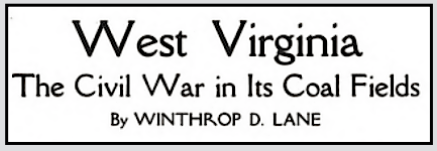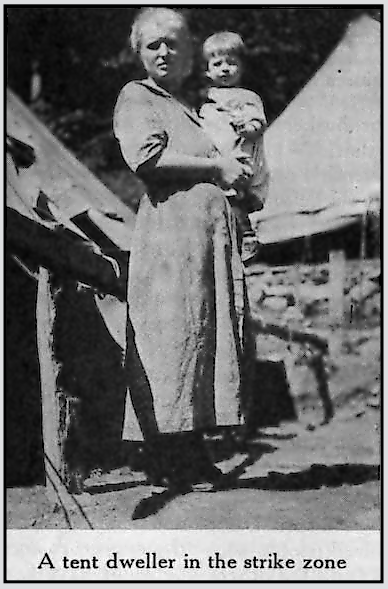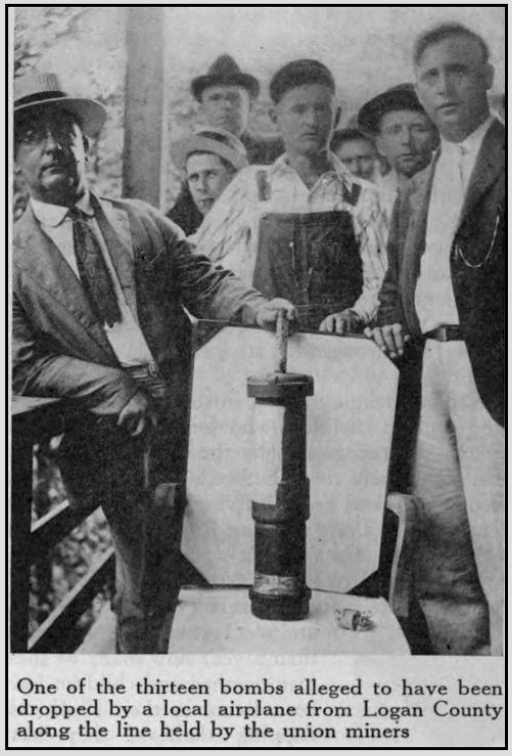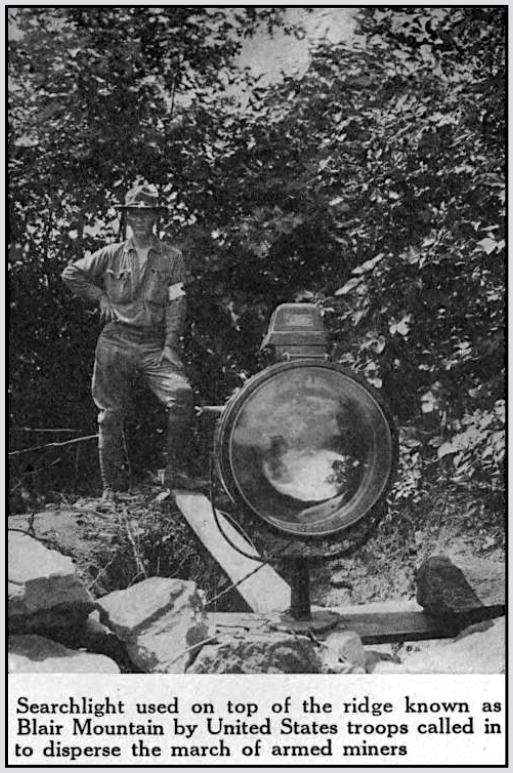 —————
—————
Hellraisers Journal – Sunday October 30, 1921
Winthrop D. Lane on West Virginia’s Coal Field War, Part I
From The Survey of October 1921:
[Part I of III.]
THE leaves are just beginning to turn on the steep hills which overlook the winding, narrow valleys of western West Virginia. Here lie some of the richest seams of bituminous coal in the world. Nature, as if to conceal her treasure, has covered all with a thick verdure of trees, impenetrable to the eye. But man has found his way into her recesses and has tunneled and bored her mountains until she has yielded her bounty. To do this an army of workmen has been employed, whose occupations have taken them underground, where day is turned into night. For thirty years many of these men have been engaged in a conflict with their employers over their right to belong to the mine workers’ union.
I have just visited the latest scenes of this conflict. Ten months ago I had spent several weeks there at a time when the huge mouths of black mines gaped in snow-clad hills. During the interval one county has been placed under martial law; violence has been rampant in a part of the state; federal troops have been called in and are still there; thousands of miners have joined in across-country march in protest against what they regarded as a violation of the rights of their fellows; engagements have been fought with airplanes and machine-guns. The conflict is farther from settlement than ever. Animosities have become keener; the atmosphere of the struggle has grown more intense. There are more arms in the troubled regions of West Virginia today, I think, than ever before.
Force is the weapon chiefly relied upon to settle the dispute.When it is not force of a direct kind, it is indirect force or repression. Jails stand crowded. Arrests are made on a wholesale scale. Grand juries vie with each other in returning indictments. The state is reorganizing her national guard. These measures are wholly divorced from any general or peaceful plan of adjustment. The acme of statesmanship seems to lie in suppressing disorder. As one goes about the state, he finds a sinister and corroding cynicism in the minds of many people. Weary of the long struggle, they no longer expect an immediate or friendly settlement. The causes of the conflict grow and fester while only the surface manifestations are given attention. Every step in the direction of settlement is a step toward the use of force, and it is force that has brought the struggle to its present proportions.
There is a tragic interest in some of the features of the conflict. Miners who joined the union and were refused recognition by the operators went on strike. They were compelled to leave their company owned houses, and are still living with their families in tent colonies along the Tug River and on the hill sides of Mingo County. It was a surprise to see, after the lapse of ten months, the same faces peering out of the same tents that were exposed to the cold and wet last winter. For more than a year now many of these men, women and children have been living in their slight and flapping shelters; they have withstood every argument of weather and unemployment to return to work. Women held up their babies and asked the visitor to see how they had grown during the interval. Men explained that they had not been entirely idle, and pointed to new floors in their tents and to other improvements.
Senator W. S. Kenyon and Senator S. M. Shortridge, who visited the tent colonies last month, found determination still strong among them.
“Hello, Senator Kenyon,” said a Negro, as the senatorial party came up. “How are you?”
“How do you know me?” asked Senator Kenyon, eyeing him critically.
“Oh, I knowed you the moment I seen you coming over that hill,” grinned the Negro. “I’m from Iowa. Us cornhuskers always knows each other.”
“Well, I guess we do,” returned Senator Kenyon. “How long have you lived around here?”
“I been here ten years.”
“Isn’t that a pretty long time to stay in a place of trouble like this?”
“I guess it is, Senator. But us cornhuskers never runs away from a fight. You know that. While the trouble lasts I’m right here. But when it’s over, believe me, I’m goin’ back to Iowa. It’s a better state than West Virginia, Senator.”
The strike in Mingo County, which has been the center of the conflict in the public mind, is, I think, lost. The operators claim that they have had their full number of employes since the first of the year and that production has not suffered from the strike since that time. They have brought in several hundred strike-breakers and have conducted a wide and costly campaign of advertising in the newspapers, partly to bring their own men back to work and partly to lay the case of the non-union employers before the public. The exact measure of their success is, of course, difficult of independent verification, but despite the thirteen or fourteen hundred people who are sticking it out in the tent colonies and the others living elsewhere, the mines would seem to be capable of running at nearly normal capacity if the demand for coal required it. Yet, the loss of this particular strike will be only an incident in the long struggle. We may expect to see the union bide its time and strike again when the occasion is ripe.
Who are the miners who are thus at odds with their employers? Native white Americans predominate among them. To one who has heard much talk of their “bolshevism” and “socialistic tendencies” this may come as a surprise. According to the annual report of the state department of mines for 1919, the latest available statistics, there are 91,566 men working “in and around the mines” of the state. Of these, 51,404 are American whites, 16,841 are Negroes, and 23,321 are of foreign nationality. Italians, Hungarians, Austrians and Poles are the chief groups of foreigners. Except for a slightly higher percentage of Negroes, the ratios do not vary much in the five counties comprising the bulk of the non-union territory, where 16,808 are American whites, 9,375 Negroes and 7,934 of foreign nationality.
Do those miners who now lack the union desire it? The owners and managers of non-union mines answer “no” to this question without fail. “Our men are satisfied as they are,” they say, and such owners and managers have done all they can to make satisfaction certain by intelligently planned and expensive welfare work. But as one goes around, he doubts the authority of their mandate to speak finally for their men on this point. Why the men who happen to be working in the mines of five particular counties in West Virginia should be so different from their fellows throughout the country is not easy to see.
Moreover, there are indications that the operators do not see all the facts. When several thousand men joined the union within a few months in Mingo County a year and a half ago the success was due in part at least to spontaneous request from the men for admission. Organizers have gone into Logan County. Despite the difficulties of talking unionism in that field, where deputy sheriffs paid by the operators keep a sharp lookout for “agitators,” petitions have been signed there by miners requesting the union to organize them. One such petition, frayed and worn, is in the files of the union in Charleston, brought out by an organizer who tramped over the hills and who concealed the petition in his shoe in order to prevent its discovery.
[Emphasis added.]
~~~~~~~~~~~~~~~~~~~~
SOURCES & IMAGES
Quote Mother Jones, June 20, 1920, Speeches Steel p213
https://books.google.com/books?id=vI-xAAAAIAAJ
https://digital.library.pitt.edu/islandora/object/pitt%3A31735035254105/viewer#page/1/mode/2up
The Survey, Volume 47
(New York, New York)
-Oct 1921 to Mar 1922
Survey Associates, 1922
https://archive.org/details/surveycharityorg47survrich/page/2/mode/2up
https://babel.hathitrust.org/cgi/pt?id=uc1.31210013389174&view=2up&seq=7&skin=2021
-Oct 29, 1921-pages 177-183
“West Virginia, Civil War in Its Coal Fields” by WD Lane
https://archive.org/details/surveycharityorg47survrich/page/176/mode/2up
See also:
More by WD Lane from The Survey Vol. 47:
Oct 1, 1921-page 23: “Senators Tour West Virginia”
https://archive.org/details/surveycharityorg47survrich/page/22/mode/2up
Oct 22, 1921-page 110: “Labor Spy in West Virginia
https://archive.org/details/surveycharityorg47survrich/page/110/mode/2up
Feb 4, 1922-page 721: “West Virginia”
https://archive.org/details/surveycharityorg47survrich/page/720/mode/2up
Feb 18, 1922-page 786: “Miners in Distress”
https://archive.org/details/surveycharityorg47survrich/page/786/mode/2up
Mar 4, 1922-page 887: “Breaking Miners”
https://archive.org/details/surveycharityorg47survrich/page/886/mode/2up
Mar 25, 1922-page 1002: “The Black Avalanche”
https://archive.org/details/surveycharityorg47survrich/page/1002/mode/2up
Tag: Winthrop Lane
https://weneverforget.org/tag/winthrop-lane/
Civil War in West Virginia
-by Winthrop David Lane
B. W. Huebsch, Incorporated, 1921
https://books.google.com/books?id=3hYtAQAAIAAJ
https://archive.org/details/civilwarinwestvi00lanerich/page/n7/mode/2up
https://catalog.hathitrust.org/Record/001432266
Tag: Mingo County Coal Miners Strike of 1920-1922
https://weneverforget.org/tag/mingo-county-coal-miners-strike-of-1920-1922/
~~~~~~~~~~~~~~~~~~~~~~~~~~~~~~~~~~~~~~~~
Fire in the Hole – Hazel Dickens




